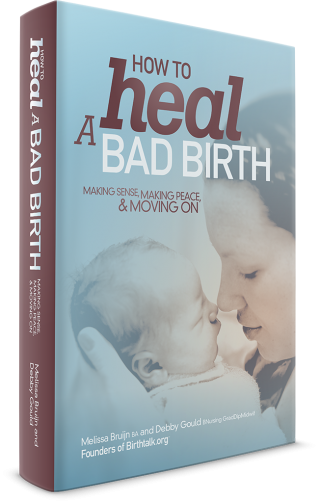
Every second Wednesday, our blog features a book review as part of our Book Club series! Check here to discover the latest books on topics such as pregnancy, labor, postpartum, and recovery from birth. If you have read the featured book or if you just finished a new and exciting book, please feel free to leave your comments and title suggestions below or email blog@ican-online.org.
How to Heal a Bad Birth: Making Sense, Making Peace, & Moving On
If ever a book needed to be published for our birthing communities, this is the one! Melissa Bruijn and Debby Gould founded Birthtalk.org in  2002 as a unique support and education organization focused on healing after a traumatic birth and working toward an empowering birth in any scenario. Born of their work in establishing support groups, empowering educational classes, community events, and seminars among online endeavors, their book, published in 2016, is an extension of their work but also a stand-alone tome that can guide mothers around the world in the healing process after a traumatic birth experience.
2002 as a unique support and education organization focused on healing after a traumatic birth and working toward an empowering birth in any scenario. Born of their work in establishing support groups, empowering educational classes, community events, and seminars among online endeavors, their book, published in 2016, is an extension of their work but also a stand-alone tome that can guide mothers around the world in the healing process after a traumatic birth experience.
The book is divided into four parts: Beginning Your Healing Journey; How Do You Feel Right Now?; Tools For Your Healing Journey; The Continuing Journey. Each section addresses a different aspect of the healing process, broken down into easy to digest parts in order to not overwhelm the reader. Included are birth stories, viewed from a mother’s emotional and mental experiences, as well as workbook-like exercises to help the reader explore and understand her own birth experience.
The first part also attempts to define what makes a birth “good” or “bad” or “traumatic.” This is really helpful in understanding that an overall birth experience may not be defined as traumatic by the mother but parts of it could have been; sometimes a birth experience can be defined as “bad” without being “traumatic.” These are nuanced definitions and it is nice to have the authors offer a breakdown of how people can define their birth experiences or not.
The second section, How Do You Feel Right Now? explores some of the more common emotions that accompany traumatic births. Defining what is “normal” or “usual” for an emotional experience or reaction and what is not can be extremely helpful in deciding whether further support assistance, such as medication or therapy, are useful in a particular healing journey. It also addresses partner issues – both the partner’s own emotions and the partner’s experience of the reader’s emotions. This is an often neglected aspect of traumatic birth; partner experience and support can be extremely important to healing a traumatic birth.
Tools For Your Healing Journey, the third section, explores different options for to add extra supportive therapies to the healing journey. These include reconnecting with the child, reconnecting with the reader’s emotional and mental self, reconnecting with the reader’s body, and even different therapeutic tools such as art. There are many choices available to the reader to exercise and use throughout her healing journey and also her partner’s healing journey.
Finally, the last section, The Continuing Journey, explores the journey in deciding to attempt birth again and how to set up that birth to be a better, more empowered experience without glossing over the traumatic previous birth experience. It is very important for the reader to understand that in most cases a “good” birth experience will not erase a “bad” or “traumatic” experience and the healing journey will still need to be traveled. Appendices are included listing several resources – organizations, online, and by phone – that can assist the reader’s healing journey and offer further and, in some cases, very specific support such as our own Internation Cesarean Awareness Network.
Overall, this is a thorough and well-written book on a topic that is very difficult to talk about, let alone address. However, healing from a traumatic birth is such an important piece of the emotional and mental experience – the journey is the process.
Purchase your copy through our Amazon Smile link and a portion of the sale will be donated to ICAN.
Reviewer: Amanda Beck, ICAN of Vancouver
Author: Melissa Bruijn and Debby Gould; Birthtalk
Photography Credit: freestocks.org via www.UnSplash.com